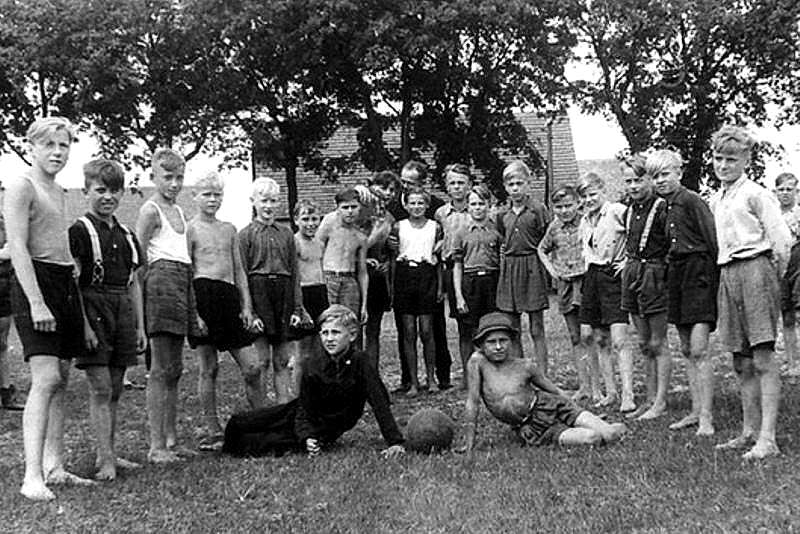
Specific German Sports

Figure 1.--After World War II we begin to see all kinds of photograph like this, German boys playing team football (soccer). They were not very common before the War. These German boys had their photo taken before a soccer match during the early-1950s. Probably some, or morelikely many, of them did not have soccer boots, so everybody played barefoot.
We suspect that the photo was taken in East Germany, but cannot be positive.
|
|
We have very little information on German sports until after World War II. The photographic record suggests that sports were not all that important before World War II. We have no information on organized youth sports in Germany during the first half of the 20th century. Soccer was growing in importance in Europe during the early-20th century. The problem for boys (girls did not participatre in soccer at the time) is that there were few places to play in the cities. Germany had an an active youth movement, but sports seems a relatively minor part of the activity program. We do note boys engaged in athletics, track and field. After the War, sports becomes much more important. Like most European countries, that shift id concentrated in one sport--football (soccer). We note modern German boys are fixated on soccer, to the exclusion of virtually all other sports. And we note them playing soccer all year round. There are even indoor facilitues for the winter. There are other sports, but noting approching the popularity of soccer.
Boxing
Boxing was not a popular sport in Germany in the 19th century, unlike America where it became very popular in the late-19th century. This only began to change after World War I when the sport began to grow in popularity. The sucess of Max Schmeling in the 1930s-30s was a factor in the sports growth. In addition, the Hitler Youth promoted fighting skills, including boxing. Other NAZI organizations promoted boxing as a manly activity. Hitler in particular approved of the sport.
Little is knowm anout the early history of skiing. Much more is known about the 19h century. Some of the earliest evidence of skiing comes from Norway. Austria and Germany played a major role in the development of modern skiing. Ski resports began to appear in the Alps at the turn of the 20th century. It was the incepotion of the winter Olympic Games that helped popularizing skiing in Germany and other countries. The first Winter Olympics was held in St. Moritz (1924). Downhill and the modern slalom events were combined for the first time to form the Arlberg-Kandahar open international alpine skiing competition, organised by Arnold Lunn and Hannes Schneider in St. Anton, Austria (1928) This event was to become the real starting point of international Alpine ski racing. Ski jumping and cross-country competition were events in the winter Olympics at Lake Placid, New York (1932). Third Winter Games of Olympics, at Garmisch include the world's first alpine events: downhill and combined slalom (1936). We are unsure just when German boys commonly began skiing. We note images from the i1930s of boys skiing. We suspect that until World War II boys who sskied were primarily those that lived in Alpine areas. Interest in skiing must have been given a boost by the Winter War (1939-40). The Finns effectively used ski troops to hold back the numerically superior Soviet invaders. Several countries formed mountain divisions with ski trainning, including the Germans. We are not sure when the Hitler Youth began proimoting ski training. We notice HJ boys leaming to ski, but the images are mostly undated. After the War there was considerable iterest in skiing in Germany.
Soccer is clearly the most important sport in Germany. In term of sports, we not many images of German boys playing football (soccer), but few playing other sports. We do not even notice a sport that German boys commonly play loke soccer. There are no seasonal alternatives as is the case in America. We notice boys even play soccer in the Winter. The basic unigform, however, does not change. Some boys play indoors. Other boys wear warm clothing like tights.
"Turnen" means "gymnastics") in German, but has a moren general meaning as well. A reader tells us, " 'Turnen' is for us a rather general term. The term 'Gymnastik/"Geräteturnen' is not very popular in general and in schools. 'The term 'Gymnastik' is more used for medical purposes, 'Krankengymnastik"/"Heilgymnastik'."
"Turnvater Jahn" (Friedrich Ludwig Jahn) is considered to be the founder of all the activities in sports/gymnastics in Germany.
HBC

Navigate the Boys' Historical Clothing Web Site:
[Return to the Main German sports page]
[Introduction]
[Activities]
[Biographies]
[Chronology]
[Clothing styles]
[Countries]
[Bibliographies]
[Contributions]
[FAQs]
[Glossaries]
[Images]
[Links]
[Registration]
[Tools]
[Boys' Clothing Home]
Created: 2:36 AM 7/11/2011
Last updated: 2:36 AM 7/11/2011



